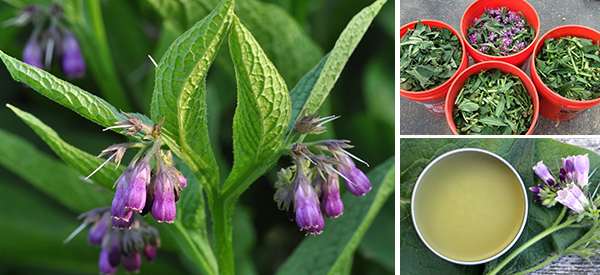
10 Things You Didn’t Know About Comfrey
Many of us are not aware of the hidden wonders in our garden. There are a lot of plants that we take for granted because we didn’t know how useful they are when it comes to our general well-being. One such plant is comfrey.
Comfrey (Symphytum) has been used for thousands of years as a natural remedy for arthritis, burns, bruises, and even diarrhea, among many other uses. Despite comfrey’s benefits to mankind, very few people are acquainted with the said plant.
With that said, I have prepared this article to introduce how wonderful (and sometimes scary) comfrey is to you. You need the proper understanding and knowledge about what the plant can do and how to take it safely so that you do not have to worry about fatal adverse reactions.
1. Wound Healer
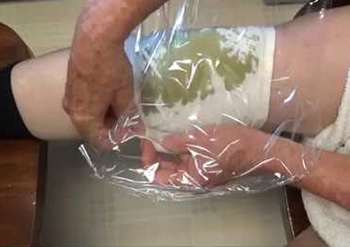 Comfrey contains vitamin C and other antioxidants that are beneficial for wound healing.
Comfrey contains vitamin C and other antioxidants that are beneficial for wound healing.
If a comfrey poultice or salve is applied to the wound, it will naturally work its wonders as the skin absorbs comfrey’s amazing healing properties. On the downside, you cannot apply comfrey when the wound is deep. Deep wounds need to heal internally first.
Hence, applying comfrey is contraindicated as it can hasten skin healing while not doing anything to heal underlying tissues. This is a ground for infection to develop, which we must avoid at all costs.
2. Great Fertilizer
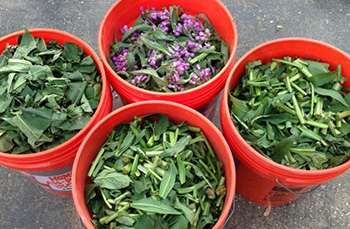 Comfrey can be prepared in many different forms, one of which is powder. Comfrey, in its powdered form, offers many wonders that are beneficial to plants.
Comfrey can be prepared in many different forms, one of which is powder. Comfrey, in its powdered form, offers many wonders that are beneficial to plants.
Why would you use chemicals when you can add natural fertilizer to your garden plants, right? All you have to do is to grind dried comfrey leaves in a blender to make the powder form.
When using the comfrey fertilizer, simply mix the powder on the soil a couple of weeks before planting. You do not need to use a lot, a sprinkle here and there will do the trick.
3. Eyewash Comfrey
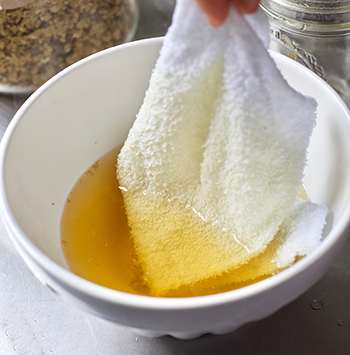 Pink eye is one nasty condition that we don’t want to get. However, when it comes, it leaves us with no choice but to deal with it. Comfrey is a good natural remedy for pink eye!
Pink eye is one nasty condition that we don’t want to get. However, when it comes, it leaves us with no choice but to deal with it. Comfrey is a good natural remedy for pink eye!
The process of making a comfrey eyewash is very easy. Mix 1 tablespoon of comfrey root powder and 1 teaspoon of organic goldenseal in 1 cup boiling water. Wait for 10-15 minutes to ensure that the nutrients from the plants are mixed with water.
Strain well and ensure that no herb particles are left. Use the liquid to wash your affected eye several times a day for five days or so, until the pink eye goes away.
4. Potent Aid for Joint Issues, Back Pain, and Sprains
Getting old means a lot of body pains that hamper us to enjoy a good day.

But will you let it push you to stay in your bed and not move at all?
Comfrey has analgesic and anti-inflammatory properties. With comfrey’s help, you can get on with your day and do your usual activities as the herb is known to lessen, if not eliminate, the pain you are feeling when you have arthritis, back pains, and injuries such as a sprain.
A comfrey ointment, oil, or poultice will work well on these ailments. For the steps in making a comfrey ointment and poultice, click here.
5. Oral Intake Of Comfrey Is Dangerous
While there are many benefits of comfrey recorded over the millennia, it is now not recommended to take it orally because of the pyrrolizidine alkaloids it contains. This component has been found out to cause cancer, liver damage, and even death when taken in huge doses.
Thus, European countries and the US Food and Drug Administration have banned the selling of any oral products that have comfrey in them.
6. Immune System Booster
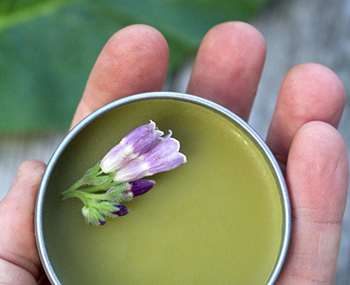 Though you cannot take comfrey orally, it can still boost your immune system in many ways. For example, using a lotion or cream with a comfrey component in it is already considered an immune booster.
Though you cannot take comfrey orally, it can still boost your immune system in many ways. For example, using a lotion or cream with a comfrey component in it is already considered an immune booster.
This is because comfrey can be absorbed through the skin. With its antioxidant and vitamin c components, you can be assured that your skin and your body get the natural boost it deserves.
7. Used As Animal Fodder
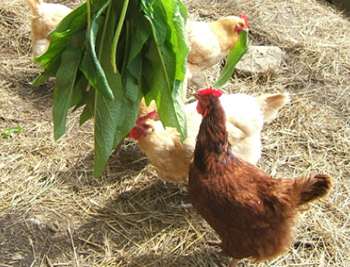 Comfrey isn’t just beneficial to humans, but to animals as well. The plant has been known to act as animal fodder for many years. The leaves are eaten by chickens, pigs, and sheep.
Comfrey isn’t just beneficial to humans, but to animals as well. The plant has been known to act as animal fodder for many years. The leaves are eaten by chickens, pigs, and sheep.
Even cattle and rabbits will eat comfrey as long as they are dried and wilted. Other animals that take comfrey as food include birds, horses, goats, and chinchillas.
8. Potatoes And Tomatoes Benefit From Comfrey A Lot
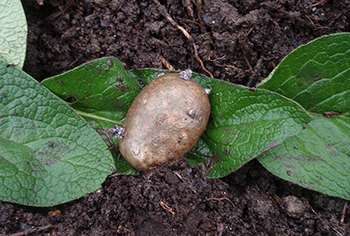 Comfrey is also great for crops! If you are cultivating potatoes and tomatoes, then you can use it to help your cultivation grow.
Comfrey is also great for crops! If you are cultivating potatoes and tomatoes, then you can use it to help your cultivation grow.
Comfrey is an ideal food for both potatoes and tomatoes because it has a near-perfect ratio of phosphorus, nitrogen, and potash. Aside from that, comfrey also acts as a compost activator and a great soil conditioner for the growth of other plants.
9. Growing Comfrey is Simple
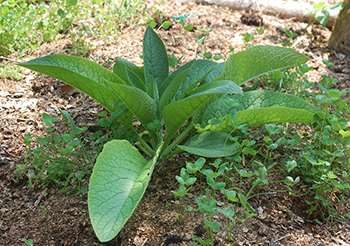 Comfrey thrives in different places across the globe. This is a clear indication that growing comfrey is easy. For places with the winter season, you can expect comfrey to “die” in the winter. However, you do not need to worry as it will just re-grow when spring comes.
Comfrey thrives in different places across the globe. This is a clear indication that growing comfrey is easy. For places with the winter season, you can expect comfrey to “die” in the winter. However, you do not need to worry as it will just re-grow when spring comes.
When growing comfrey, it is best to start from root or crown cuttings. Crown cuttings will grow faster than root cuttings.
10. Unsafe For Breastfeeding And Pregnant Women
With all the health benefits of comfrey, I couldn’t blame you if you want to share it with your daughters, granddaughters, nieces, and young lady friends. However, you need to be aware that comfrey isn’t safe to use by pregnant women and those who are breastfeeding because of the pyrrolizidine alkaloids it contains. Moreover, this may be transmitted to the unborn baby and may cause birth defects. Hence, you should be careful when you recommend it to young women.
Regardless of the downsides, you must know by now that comfrey is a must-have plant after all of these trivia and facts! While there are dangers to the use of comfrey, you can still use it safely in recommended doses and forms such as ointments and salves. Do not be scared of comfrey! It is a great plant with many benefits as long as you use it carefully.
You may also like:
 15 Common Herbal Mistakes You Are Probably Making Right Now!
15 Common Herbal Mistakes You Are Probably Making Right Now!
The 10 Medicinal Seeds You Should Plant for a Complete Backyard Pharmacy (Video)
How to Reduce Pain Triggered by Weather Changes
Garden Homemade Salve for Wrinkles
10 Herbal Medicine Rules That are actually Myths
If you liked our article don’t forget to pin it!
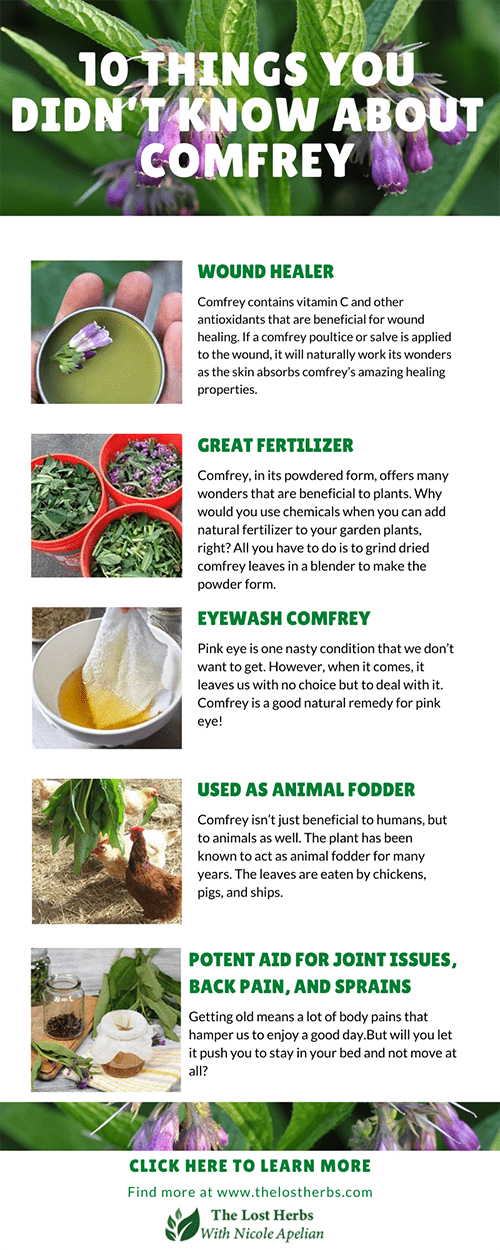

I’ve been giving all my comfrey to animals, had no idea I could use it myself! Hopefully I’ll make my joints happy as well
Often as I work in my food forest I get cut or scraped. Having last year started some comfrey I put it on a shallow wound. The healing was swift. I have lots of aloe Vera plants around and usually use them but the comfrey worked better.
I mix comfrey, calendula, a couple other ingredients to make home made neosporin.. It works great, things heal pretty fast. I even put it on my cats wounds.
Crown vs roots? How does one gather just the crown?
How can I start growing comfrey in my garden?
Where should I get seeds, or crown tops?
Hi Iris,
Thank you for your comment.
You can find more information about growing your own comfrey in the article below:
https://growingorganic.com/growing-guide/comfrey/
Regarding the seeds, you can order from Amazon, Etsy, or a local seed supplier.
God bless!
I love your site and have learned so much, even tho I have been working with herbs for years, so thank you for all you do to support the herb world!
A question about comfrey: Since it creates skin growth how does this work with psoriasis.. already an over abundance of skin cell growth.
Hi Susan,
Thank you so much for your support.
You can try Comfrey as well, just apply a small amount to a small affected area first. However, a better option would be the Oregon grape. The stem and leaves of the plant can be ground into a powder or distilled into an extract that is then used to make a topical skin cream. It’s been found to reduce redness in psoriatic flares when used topically.
God bless!
If it’s not safe for human consumption how can it be safe for animal food?
Hi Rose,
The animal’s digestive system is different than ours.
Comfrey being low in fiber but high in protein is the ideal green to feed chickens. The allantoin is potentially health-promoting and the high levels of Vitamins A & B12 result in both a rich yellow yolk to the eggs and a yellow tinge to the flesh as with the expensive corn-fed hens.
God bless!
Thank you.
Comfrey is a wonderful plant that has other meaningful names which add to our understanding of what is is known by and can be used for. Take the name Boneset, ie to be used with broken bones that need to be repaired. Another name is Knit bone. That is because it was used to basically knit your bones back together. Comfrey or knitbone; boneset has been used well before the advent of modern medicine. The indians used it in a poultice where they would wrap the large hairy leaves around the affected area. It healing properties are drawn out of the leaves by using an infusion method or just making a tea. You can use the hot water by dipping the leaves through the hot water and carefully wrapping these large natural bandages (leaves) around the wound. Drinking a small amount of the tea is also helpful. The Indians knew they could keep the poultices around the injured area and Comfrey would dissolve the broken bone that protrudes from the skin. Comfrey acts as calcium dissolver and adds the calcium back to where the DNA has already “known of what your bone naturally looks like. Please be advised that this natural remedies was employed in the time before modern medicine and broken bone setting. It would be, in today’s understanding, imprudent to not use the advances of modern science in setting bones. Healing time is shorten dramatically in today’s bone healing technology. Nevertheless, knowing that comfrey is still helpful as a poultice and would also help with bruises and other skin related disorder is a Godsend. Many home gardeners would just plant comfrey because it has beautiful blue to purplish colored flower and not realize it has the poultice and salve healing properties of one of God’s most useful healing plants.
Hi, I would like to know if there are recipes for the use of comfrey tincures? I made that last year because I didn’t wanted to throw away the plants my dad harvested. I didn’t know then how to make comfrey oil…
Typo: ‘tincures’ has to be ‘tinctures’…